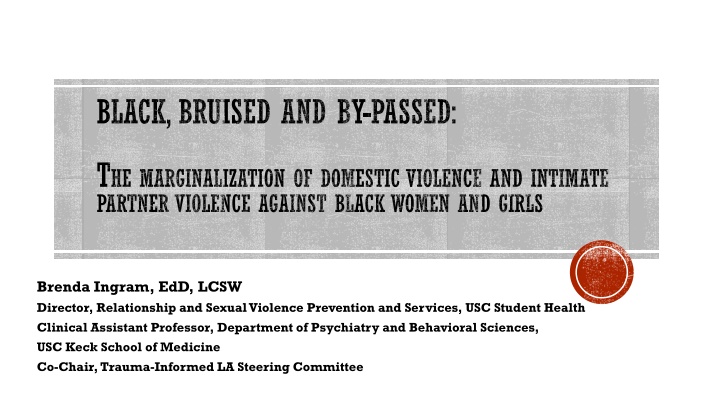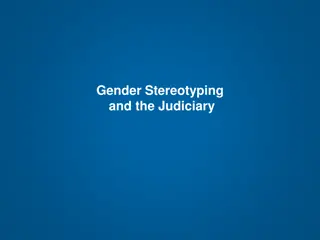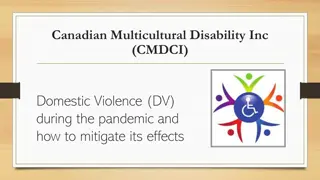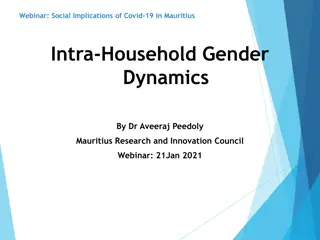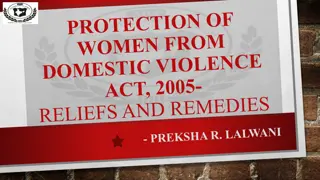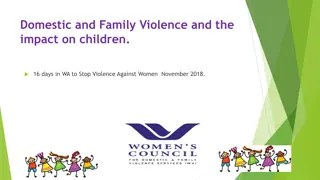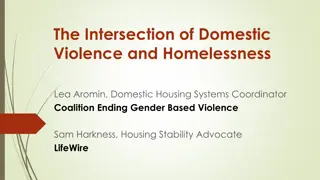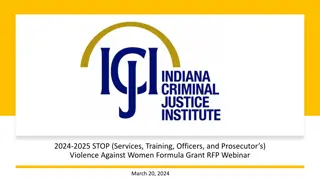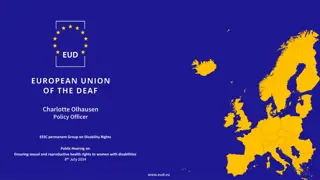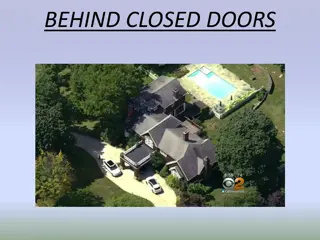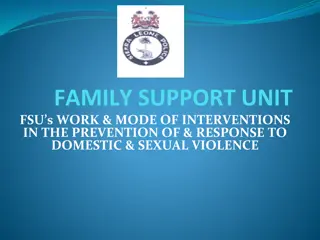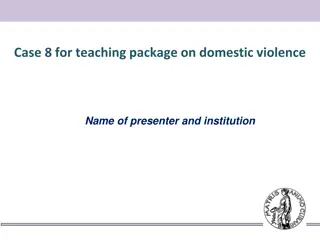Marginalization of Domestic Violence Against Black Women
Domestic violence and intimate partner violence against Black women and girls is a pressing issue that often goes unrecognized. The statistics reveal a disturbing trend of higher rates of abuse and fatalities among Black females compared to other racial/ethnic groups. These acts of violence are not isolated incidents but are deeply rooted in systemic issues that perpetuate the marginalization and victimization of Black women. Gun violence, in particular, poses a significant threat, with a high correlation to domestic violence incidents. Recognizing and addressing this pervasive problem is crucial to safeguarding the lives and well-being of Black women and girls.
Download Presentation

Please find below an Image/Link to download the presentation.
The content on the website is provided AS IS for your information and personal use only. It may not be sold, licensed, or shared on other websites without obtaining consent from the author.If you encounter any issues during the download, it is possible that the publisher has removed the file from their server.
You are allowed to download the files provided on this website for personal or commercial use, subject to the condition that they are used lawfully. All files are the property of their respective owners.
The content on the website is provided AS IS for your information and personal use only. It may not be sold, licensed, or shared on other websites without obtaining consent from the author.
E N D
Presentation Transcript
BLACK, BRUISED AND BY-PASSED: THE MARGINALIZATION OF DOMESTIC VIOLENCE AND INTIMATE PARTNER VIOLENCE AGAINST BLACK WOMEN AND GIRLS Brenda Ingram, EdD, LCSW Director, Relationship and Sexual Violence Prevention and Services, USC Student Health Clinical Assistant Professor, Department of Psychiatry and Behavioral Sciences, USC Keck School of Medicine Co-Chair, Trauma-Informed LA Steering Committee
DOMESTIC VIOLENCE CAN HAPPEN TO ANYONE
DOMESTIC VIOLENCE/INTIMATE PARTNER VIOLENCE (IPV) AGAINST BLACK WOMEN AND GIRLS Each year thousands of black women and girls are beaten, brutalized, murdered, and stalked by intimate partners, ex-partners, strangers, and friends. Most of these stories fly under the mainstream media radar and the black victims are unnamed, marginalized and ignored. Black women experience intimate partner and domestic violence at a rate that is 35% higher than for white women. They are also more likely than whites to be teen dating violence victims (Women of Color Network (WOCN)/National Resource Center on Domestic Violence (NRCDV))
DOMESTIC VIOLENCE/INTIMATE PARTNER VIOLENCE AGAINST BLACK WOMEN AND GIRLS Domestic violence is one of the leading causes of death for black women and girls aged 15 to 35. Black women are 3 times more likely to die at the hands of their current partner or ex-partner than any other racial/ethnic group. Almost half who are killed are killed while trying to leave an abusive relationship (WOCN/NRCDV). Gun violence is highly correlated with domestic violence. In mass shooting incidents, 54% are related to domestic or family violence. In more than half of the single victim/single offender murder cases where the weapon could be identified, black women were killed with a firearm.
DOMESTIC VIOLENCE/INTIMATE PARTNER VIOLENCE AGAINST BLACK WOMEN AND GIRLS The number of black females shot and killed by their husband or intimate acquaintance was more than three times as high as the total number murdered by male strangers using all weapons combined in single victim/single offender incidents (Violence Policy Center, 2016).
DATING VIOLENCE AGAINST BLACK GIRLS According to the National Survey of Risk Behaviors conducted by the CDC(2013): Youth of color are forced to have sexual intercourse at higher rates than white youth. And black girls have the second highest rate behind Hispanic girls. An earlier report of the CDC (2003) had black girls with higher rates of physical dating violence (14%) which was significantly higher that white girls (7.5%). In this study white girls have a higher rate than black girls (2013), but Hispanic girls have the highest rate.
DATING VIOLENCE AGAINST BLACK GIRLS TDV in high school is also linked to increased risk of re-victimization through intimate partner violence (IPV) later in life. It has been found that for black girls, cumulative exposure to violence increased their risk of experiencing multiple forms of victimization. Furthermore, it has been found that black and other adolescents, who had one or more adverse family violence experiences in childhood, including physical or sexual abuse or witnessing abuse among family members, were at an increased risk of perpetration of IPV, TDV, bullying, and other aggressive experiences.
INTIMATE PARTNER VIOLENCE AGAINST BLACK LESBIANS There is a dearth of data available on prevalence rates of IPV or IPA for black lesbians. Black lesbians represent a high risk population that has gone under-researched and consequently underserved Estimates of prevalence rates for black lesbian IPV/IPA could range from 25 % to 40 %, with the higher end of the range representing the inclusion of nonphysical forms of abuse (i.e., verbal abuse, intimidation, and coercion). Abuse within their intimate relationships is exacerbated and reinforced by larger societal bias, discrimination and even hate violence in a survivor s family, workplace, neighborhood and the world at large.
INTIMATE PARTNER VIOLENCE AGAINST BLACK LESBIANS Intimate partner abuse and other destructive behaviors are more likely to occur when black lesbians (and other individuals) who have experienced trauma and oppression are unable to develop effectual mitigating coping strategies, in addition to having inadequate access to effective interventions and resources. Fifty percent of LGBT people murdered (n=21) by their intimate partners in 2013 were people of color. The highest level of DV homicide in the LGBT community in history. Transgendered person of color is 2.6x more likely to become a victim of IPV than a non-LGBT person.
CRIMINALIZATION OF BLACK WOMEN WHO DEFEND THEMSELVES Rarely, are the black women seen as innocent victims. They are characterized as criminals when they engage in acts of self-defense. In 1991, the ratio of black women to white women convicted of killing their abusive husbands was nearly two to one. Women of color and low income women are disproportionately affected by mandatory arrest policies for domestic violence. Of survivors in a New York City study who had been arrested along with their abusers (dual arrest cases) or arrested as a result of a complaint lodged by their abuser (retaliatory arrest cases), 66% were African American or Latina,43% were living below the poverty line, and 19% percent were receiving public assistance at the time (Survived and Punished.org).
BLACK WOMEN, DOMESTIC VIOLENCE AND HOMELESSNESS Domestic violence is a leading cause of homelessness for women and children. It has been estimated that domestic violence accounts for almost 50% of homeless women and children. Homeless families are about 34% of the homeless population and black women with children represent 43% of those families. Clearly when blacks represent only 16% of the U.S. population, there is a dramatic disproportionality of homelessness in this group. Due to black women s socioeconomic status coupled with historical and current racism, they are more likely to become homeless due to domestic violence and harder to place in housing. Many must choose between homelessness and living with abuse. It can be a no win situation.
INTERSECTIONALITY IN THE LIVES OF BLACK WOMEN AND GIRLS The high incidence of domestic violence in the black community can be explained by the theory of intersectionality. This means there are multiple, overlapping factors and oppressions that contribute to the high incidence of domestic violence with its many far reaching consequences. Contributing factors include, historical trauma, sexism, racism, classism/poverty, heterosexism, homophobia, social injustice, etc. create an environment that sustains the use of violence to resolve conflicts. Racialized sexism the intersectional experience of racism and sexism
INTERSECTIONALITY IN THE LIVES OF BLACK WOMEN AND GIRLS The consequences of these contributing factors coupled with domestic violence lead to significant health disparities ( higher rates of chronic illnesses and higher rates of mortality), homelessness with limited access to affordable housing, high rates of incarceration, poor educational outcomes, higher rates of trauma, mental illness and substance abuse, high rates of interpersonal conflict, and a reduction in overall well-being. For communities of color and other marginalized communities, it is vital to de-construct the intersectionality in order to eliminate these consequences.
Intersectionality for DV/IPV in Marginalized Communities Poverty or Socioeconomic Hardship Inadequate housing, education, social resources and employment; workplace discrimination and social marginalization Exposure to community violence, persistent threat of victimization (e.g., harassment, assault, bashing); lack of police protection Intersecting Forms of Oppression Childhood exposure to family and community violence or IPA; child abuse, neglect, bullying; intergenerational patterns of poverty, trauma, and mental health symptoms Traumatic Experiences Depression, PTSD, anxiety, low self- esteem, rage, shame, personality disorders, and substance abuse Disempowerment, self-devaluation; internalization of racism, sexism, heterosexism, etc. Mental Health Symptoms Hill, Woodson, Ferguson & Parks, 2012
USING AN INTERSECTIONALITY PARADIGM TO DEVELOP SOLUTIONS TO DOMESTIC VIOLENCE Be mindful of the fact that even though black women and girls have been negatively impacted by multiple oppressive factors, they have also developed resiliencies from their adaptation to these multiple oppressions. Institutions need to be educated on the various types of oppressions, so that they can develop or alter policies and practices to address intersectionality of these risk factors. For example, housing is a great need for black women trying to flee an abusive situation and many face biases and economic barriers to housing. Training and doing advocacy with the housing providers on implicit bias and developing funding formulas or even cooperative housing would help to alleviate some of these constraints.
USING AN INTERSECTIONAL PARADIGM TO DEVELOP SOLUTIONS TO DOMESTIC VIOLENCE Due to the multiple risk factors of intersectionality, one way to reduce or eliminate DV/IPV is to increase protective factors. These protective factors would include adequate access to socioeconomic supports (e.g., employment and education), social justice and community resources, mental health services, as well as personal empowerment. What are the protective factors that already exist in the black community? How can they be enhanced? Personal resilience factors Community organizations Families
ADDRESSING THE DOMESTIC VIOLENCE/INTIMATE PARTNER VIOLENCE WITH BLACK WOMEN AND GIRLS As service providers, the first step in providing services to reduce domestic violence in the black community or any other marginalized community is to assess your organizational structure and culture. What is the perception of your agency in the community? Do you practice cultural humility? Has the agency analyzed it own policies and practices? What does your staffing look like? Is your agency trauma- informed? Not before you have done an analysis of organizational capacity through the lens of intersectionality, can the real work of eliminating domestic violence with black women and girls begin.
CONTACT INFORMATION Brenda Ingram, EdD, LCSW BrendaKaye.Ingram@med.usc.edu Brenda.Ingram4@Verizon.net
